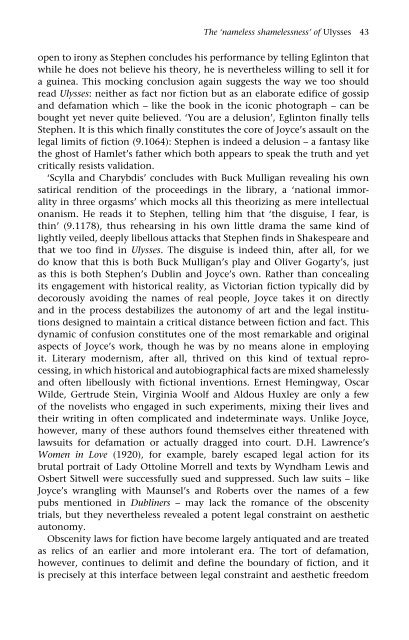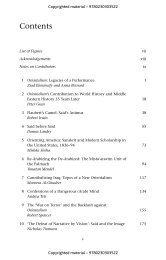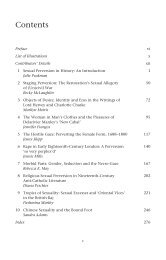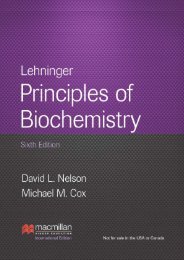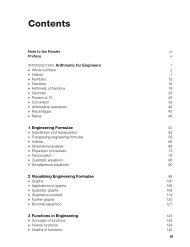The Nameless Shamelessness of Ulysses - Palgrave
The Nameless Shamelessness of Ulysses - Palgrave
The Nameless Shamelessness of Ulysses - Palgrave
Create successful ePaper yourself
Turn your PDF publications into a flip-book with our unique Google optimized e-Paper software.
<strong>The</strong> ‘nameless shamelessness’ <strong>of</strong> <strong>Ulysses</strong> 43<br />
open to irony as Stephen concludes his performance by telling Eglinton that<br />
while he does not believe his theory, he is nevertheless willing to sell it for<br />
a guinea. This mocking conclusion again suggests the way we too should<br />
read <strong>Ulysses</strong>: neither as fact nor fiction but as an elaborate edifice <strong>of</strong> gossip<br />
and defamation which – like the book in the iconic photograph – can be<br />
bought yet never quite believed. ‘You are a delusion’, Eglinton finally tells<br />
Stephen. It is this which finally constitutes the core <strong>of</strong> Joyce’s assault on the<br />
legal limits <strong>of</strong> fiction (9.1064): Stephen is indeed a delusion – a fantasy like<br />
the ghost <strong>of</strong> Hamlet’s father which both appears to speak the truth and yet<br />
critically resists validation.<br />
‘Scylla and Charybdis’ concludes with Buck Mulligan revealing his own<br />
satirical rendition <strong>of</strong> the proceedings in the library, a ‘national immorality<br />
in three orgasms’ which mocks all this theorizing as mere intellectual<br />
onanism. He reads it to Stephen, telling him that ‘the disguise, I fear, is<br />
thin’ (9.1178), thus rehearsing in his own little drama the same kind <strong>of</strong><br />
lightly veiled, deeply libellous attacks that Stephen finds in Shakespeare and<br />
that we too find in <strong>Ulysses</strong>. <strong>The</strong> disguise is indeed thin, after all, for we<br />
do know that this is both Buck Mulligan’s play and Oliver Gogarty’s, just<br />
as this is both Stephen’s Dublin and Joyce’s own. Rather than concealing<br />
its engagement with historical reality, as Victorian fiction typically did by<br />
decorously avoiding the names <strong>of</strong> real people, Joyce takes it on directly<br />
and in the process destabilizes the autonomy <strong>of</strong> art and the legal institutions<br />
designed to maintain a critical distance between fiction and fact. This<br />
dynamic <strong>of</strong> confusion constitutes one <strong>of</strong> the most remarkable and original<br />
aspects <strong>of</strong> Joyce’s work, though he was by no means alone in employing<br />
it. Literary modernism, after all, thrived on this kind <strong>of</strong> textual reprocessing,<br />
in which historical and autobiographical facts are mixed shamelessly<br />
and <strong>of</strong>ten libellously with fictional inventions. Ernest Hemingway, Oscar<br />
Wilde, Gertrude Stein, Virginia Woolf and Aldous Huxley are only a few<br />
<strong>of</strong> the novelists who engaged in such experiments, mixing their lives and<br />
their writing in <strong>of</strong>ten complicated and indeterminate ways. Unlike Joyce,<br />
however, many <strong>of</strong> these authors found themselves either threatened with<br />
lawsuits for defamation or actually dragged into court. D.H. Lawrence’s<br />
Women in Love (1920), for example, barely escaped legal action for its<br />
brutal portrait <strong>of</strong> Lady Ottoline Morrell and texts by Wyndham Lewis and<br />
Osbert Sitwell were successfully sued and suppressed. Such law suits – like<br />
Joyce’s wrangling with Maunsel’s and Roberts over the names <strong>of</strong> a few<br />
pubs mentioned in Dubliners – may lack the romance <strong>of</strong> the obscenity<br />
trials, but they nevertheless revealed a potent legal constraint on aesthetic<br />
autonomy.<br />
Obscenity laws for fiction have become largely antiquated and are treated<br />
as relics <strong>of</strong> an earlier and more intolerant era. <strong>The</strong> tort <strong>of</strong> defamation,<br />
however, continues to delimit and define the boundary <strong>of</strong> fiction, and it<br />
is precisely at this interface between legal constraint and aesthetic freedom


